A New Thin Seam Backfill Mining Technology and Its Application
Abstract
:1. Introduction
2. Geological and Geotechnical Overview
2.1. Working Face Overview
2.2. Coal Seam and Strata
2.3. The Mining Method
2.4. The Situation of the Ground Village
3. A New Thin Seam Backfill Mining Technology
3.1. The Development of the Filling Material
3.1.1. Raw Materials
3.1.2. Experimental Study on the Performance of the Filling Material
3.2. Design of the Filling System
3.2.1. Filling System
3.2.2. Parameters and Equipment Selection of the Filling System
3.3. Key Technologies for Thin Seam Working Face Filling
3.3.1. Retaining Support
3.3.2. “Y” Type Two-Way Selection Cut-off Gate
3.3.3. Gob-Side Entry Retaining
4. Roof Control Effect of Backfilling Mining
4.1. Installation of the Observation Instrument
4.2. Result Analysis
5. Discussion
6. Conclusions
- (1)
- When the ratio of water to fly ash to gangue is appropriate and proper cement is added, the developed cemented gangue filling material can meet both the pumping liquidity and the strength requirements of the filling body during the early and late stages.
- (2)
- The operation of the filling system was coordinated to meet the requirements of long-term continuous operation of the filling project. The design and equipment selection of the paste filling system were reasonable.
- (3)
- By using the key technologies for thin seam working face filling, the time needed for working the face filling, the connection and disconnection of the filling pipeline and gob-side entry retaining were all greatly shortened. The labor intensity of the workers was reduced, and the mechanization level of the mine was improved.
- (4)
- With the advancement of the working face, the stresses acting on the filling body and the roof subsidence of the filling area were first increased rapidly. When the distance of the working face advancement was more than approximately 80 m, the increase rate gradually decreased, and when the working face was advanced by approximately 120 m, the filling body gradually reached its ultimate strength and became stable. As a result, the stress and roof subsidence were no longer changing. These results show that if the roof subsidence is effectively controlled, then the ground subsidence can be reduced, and good results can be achieved.
Acknowledgments
Author Contributions
Conflicts of Interest
References
- Zhu, W.; Xu, J.; Xu, J.; Chen, D.; Shi, J. Pier-column backfill mining technology for controlling surface subsidence. Int. J. Rock Mech. Min. 2017, 96, 58–65. [Google Scholar] [CrossRef]
- Chen, S.; Yin, D.; Cao, F.; Liu, Y.; Ren, K. An overview of integrated surface subsidence-reducing technology in mining areas of China. Nat. Hazards 2016, 81, 1129–1145. [Google Scholar] [CrossRef]
- Yin, W.; Chen, Z.; Quan, K.; Mei, X. Strata behavior at fully-mechanized coal mining and solid backfilling face. SpringerPlus 2016, 5. [Google Scholar] [CrossRef] [PubMed]
- Li, H.; Guo, G.; Zhai, S. Mining scheme design for super-high water backfill strip mining under buildings: A Chinese case study. Environ. Earth Sci. 2016, 75. [Google Scholar] [CrossRef]
- Chang, Q.; Chen, J.; Zhou, H.; Bai, J. Implementation of Paste Backfill Mining Technology in Chinese Coal Mines. Sci. World J. 2014, 2014, 1–8. [Google Scholar] [CrossRef] [PubMed]
- Farhad Howladar, M.; Mostafijul Karim, M. The selection of backfill materials for Barapukuria underground coal mine, Dinajpur, Bangladesh: Insight from the assessments of engineering properties of some selective materials. Environ. Earth Sci. 2015, 73, 6153–6165. [Google Scholar] [CrossRef]
- Wu, D.; Yang, B.; Liu, Y. Transportability and pressure drop of fresh cemented coal gangue-fly ash backfill (CGFB) slurry in pipe loop. Powder Technol. 2015, 284, 218–224. [Google Scholar] [CrossRef]
- Liu, J.; Sui, W.; Zhao, Q. Environmentally sustainable mining: A case study of intermittent cut-and-fill mining under sand aquifers. Environ. Earth Sci. 2017, 76. [Google Scholar] [CrossRef]
- Zhang, Q.; Zhang, J.; Kang, T.; Sun, Q.; Li, W. Mining pressure monitoring and analysis in fully mechanized backfilling coal mining face—A case study in Zhai Zhen Coal Mine. J. Cent. South Univ. 2015, 22, 1965–1972. [Google Scholar] [CrossRef]
- Wu, D.; Sun, G.; Liu, Y. Modeling the thermo-hydro-chemical behavior of cemented coal gangue-fly ash backfill. Constr. Build. Mater. 2016, 111, 522–528. [Google Scholar] [CrossRef]
- Ma, F.; Zhao, H.; Yuan, R.; Guo, J. Ground movement resulting from underground backfill mining in a nickel mine (Gansu Province, China). Nat. Hazards 2015, 77, 1475–1490. [Google Scholar] [CrossRef]
- Sivakugan, N.; Rankine, R.M.; Rankine, K.J.; Rankine, K.S. Geotechnical considerations in mine backfilling in Australia. J. Clean. Prod. 2006, 14, 1168–1175. [Google Scholar] [CrossRef]
- Zhou, N.; Zhang, J.; Yan, H.; Li, M. Deformation Behavior of Hard Roofs in Solid Backfill Coal Mining Using Physical Models. Energies 2017, 10, 557. [Google Scholar] [CrossRef]
- Zhang, J.; Gao, R.; Li, M.; Cao, S.; Liu, S. Basic Characteristics and Effective Control of Gangue Piles in Mining Areas: A Case Study. J. Residuals Sci. Technol. 2015, 12, S145–S154. [Google Scholar] [CrossRef]
- Huang, Y.; Zhang, J.; Yin, W.; Sun, Q. Analysis of Overlying Strata Movement and Behaviors in Caving and Solid Backfilling Mixed Coal Mining. Energies 2017, 10, 1057. [Google Scholar] [CrossRef]
- Zhang, J.; Zhang, Q.; Spearing, A.J.S.S.; Miao, X.; Guo, S.; Sun, Q. Green coal mining technique integrating mining-dressing-gas draining-backfilling-mining. Int. J. Min. Sci. Technol. 2017, 27, 17–27. [Google Scholar] [CrossRef]
- Huang, Y.; Li, J.; Song, T.; Kong, G.; Li, M. Analysis on Filling Ratio and Shield Supporting Pressure for Overburden Movement Control in Coal Mining with Compacted Backfilling. Energies 2017, 10, 31. [Google Scholar] [CrossRef]
- Li, M.; Zhang, J.; Huang, Y.; Zhou, N. Effects of particle size of crushed gangue backfill materials on surface subsidence and its application under buildings. Environ. Earth Sci. 2017, 76. [Google Scholar] [CrossRef]
- Zhang, J.; Zhang, Q.; Sun, Q.; Gao, R.; Germain, D.; Abro, S. Surface subsidence control theory and application to backfill coal mining technology. Environ. Earth Sci. 2015, 74, 1439–1448. [Google Scholar] [CrossRef]
- Zhang, X.; Lin, J.; Liu, J.; Li, F.; Pang, Z. Investigation of Hydraulic-Mechanical Properties of Paste Backfill Containing Coal Gangue-Fly Ash and Its Application in an Underground Coal Mine. Energies 2017, 10, 1309. [Google Scholar] [CrossRef]
- China State Adminstration of Quality Supervision. Spection and Quarantine; GB/T1596–2005 Flyash used for cement and concrete [S]; Standards Press of China: Beijing, China, 2005.
- Witteman, M.L.; Simms, P.H. Unsaturated flow in hydrating porous media with application to cemented mine backfill. Can. Geotech. J. 2017, 54, 835–845. [Google Scholar] [CrossRef]
- Qi, T.; Feng, G. Resistivity and AE Response Characteristics in the Failure Process of CGB under Uniaxial Loading. Adv. Mater. Sci. Eng. 2017, 2017, 1–11. [Google Scholar] [CrossRef]
- Gong, P.; Ma, Z.; Zhang, R.R.; Ni, X.; Liu, F.; Huang, Z. Surrounding Rock Deformation Mechanism and Control Technology for Gob-Side Entry Retaining with Fully Mechanized Gangue Backfilling Mining: A Case Study. Shock Vib. 2017, 2017, 6085941. [Google Scholar] [CrossRef]
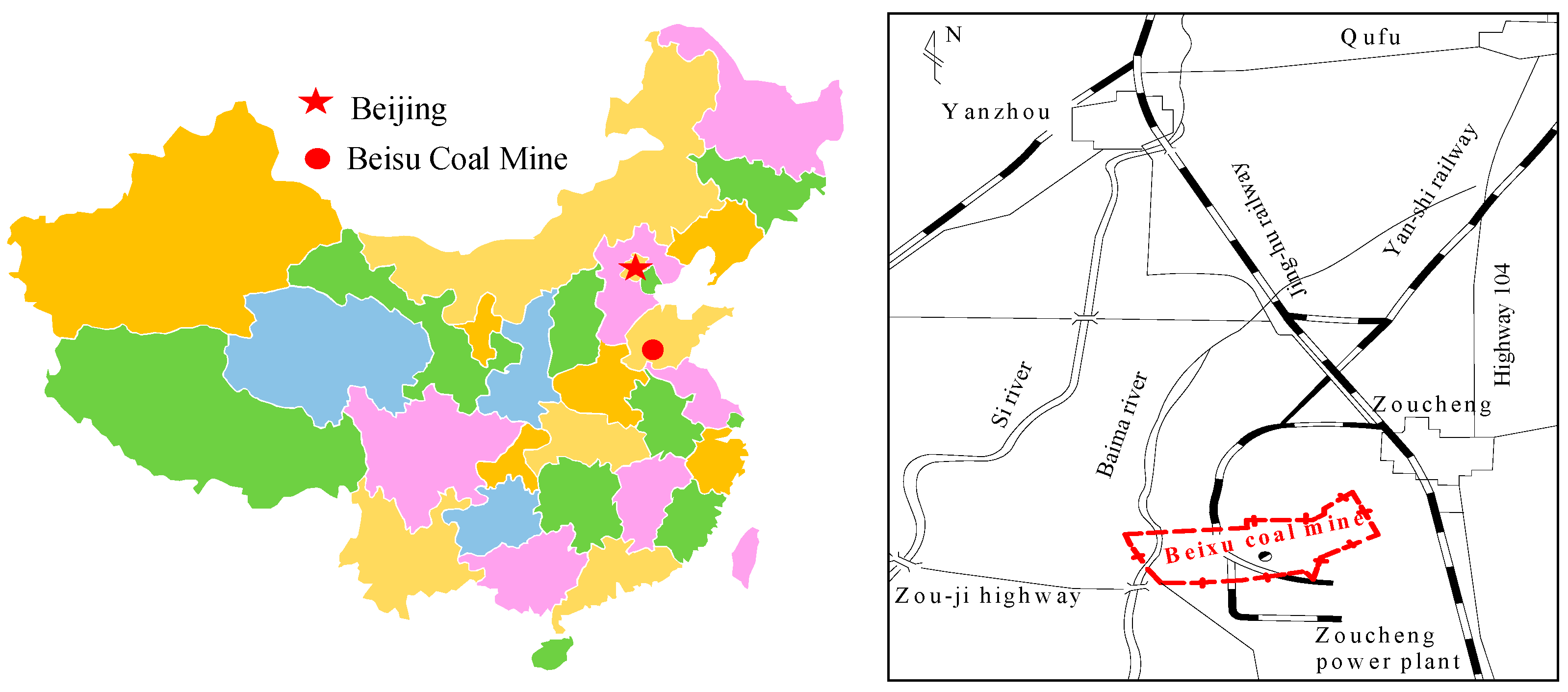

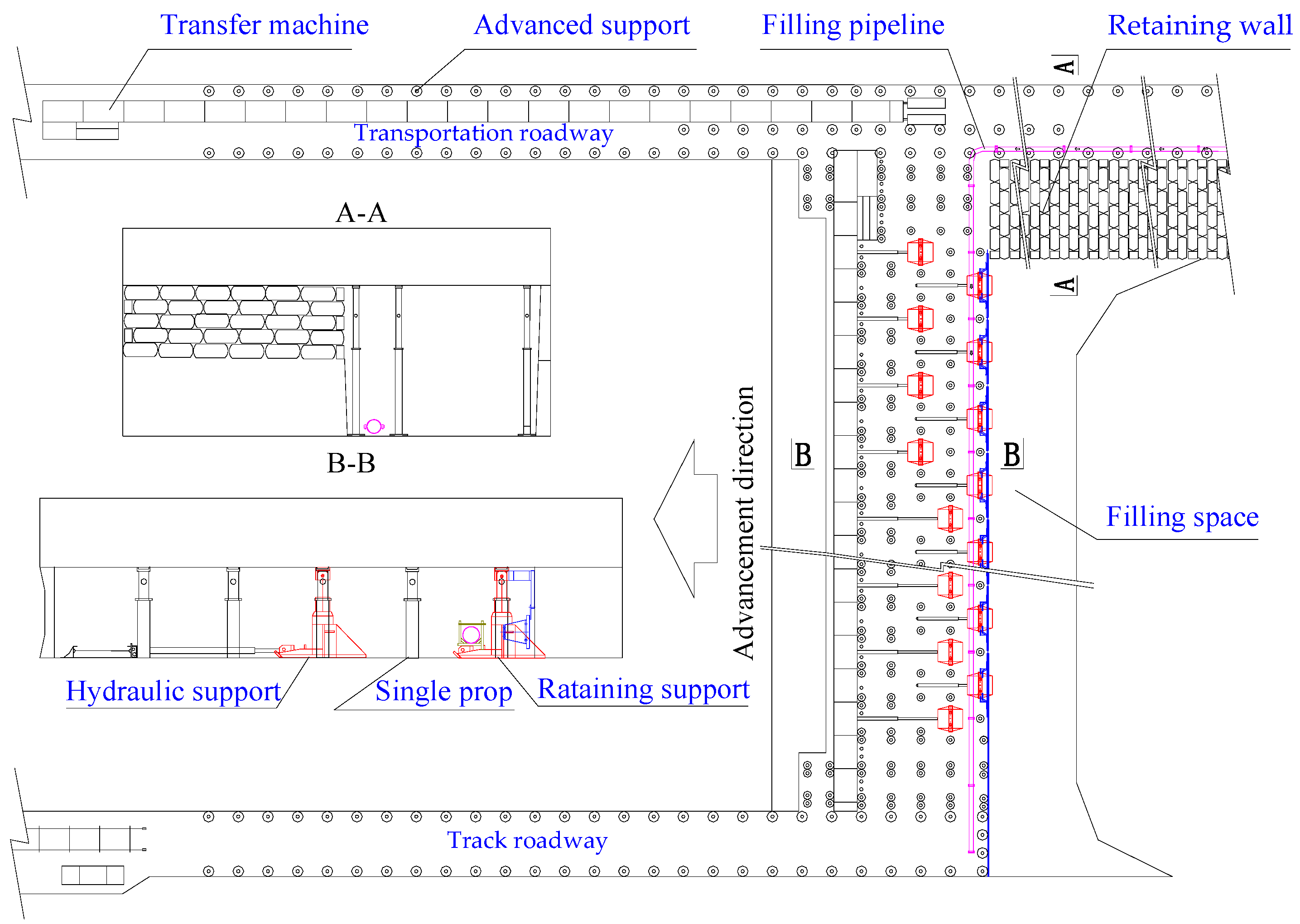
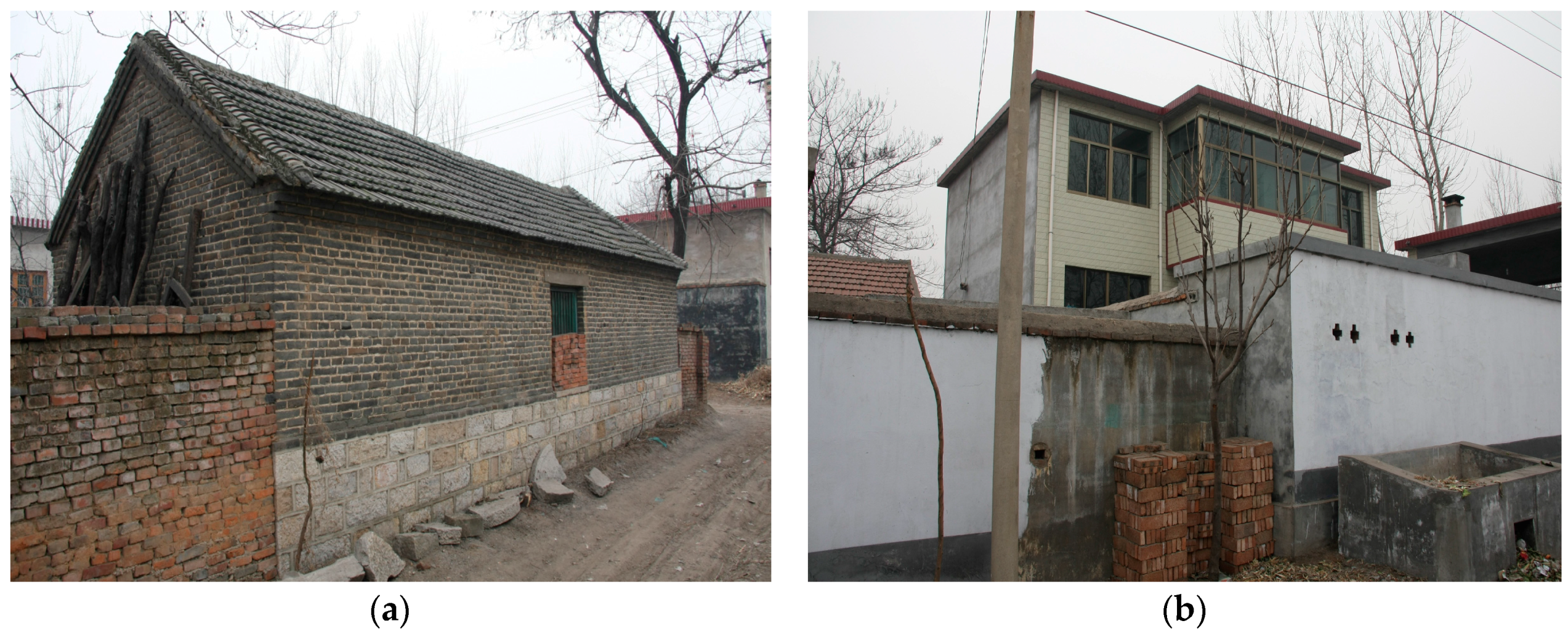
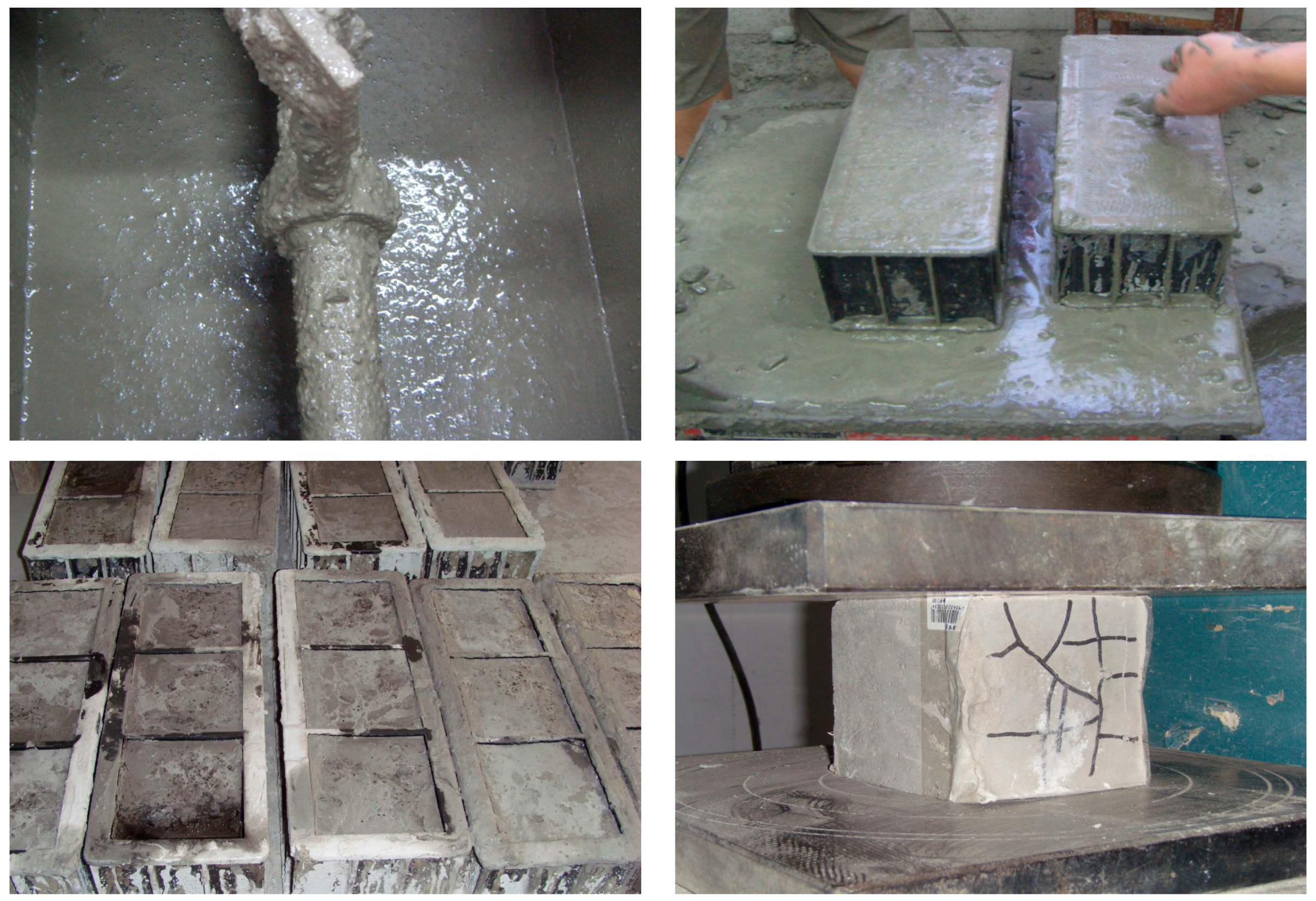
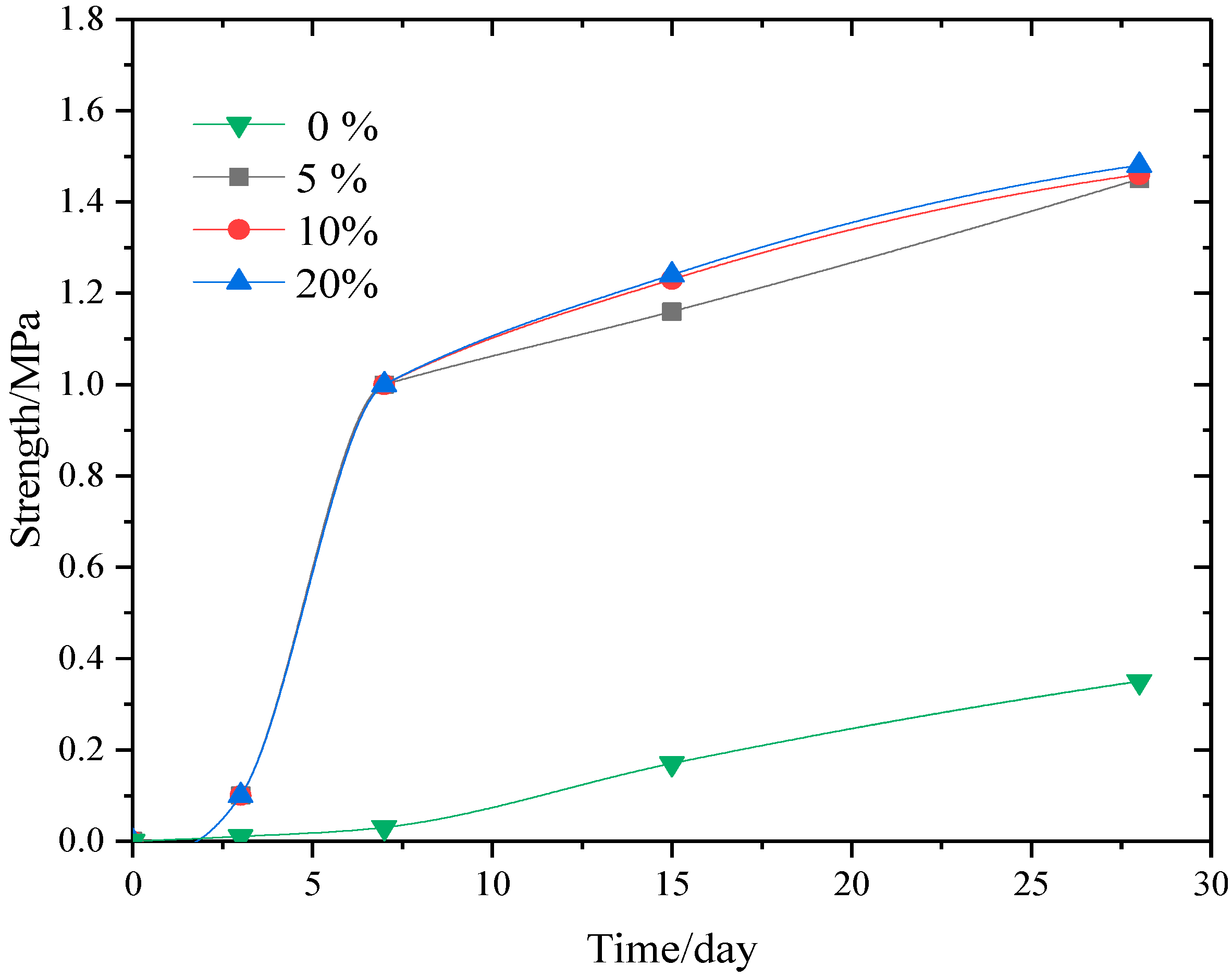
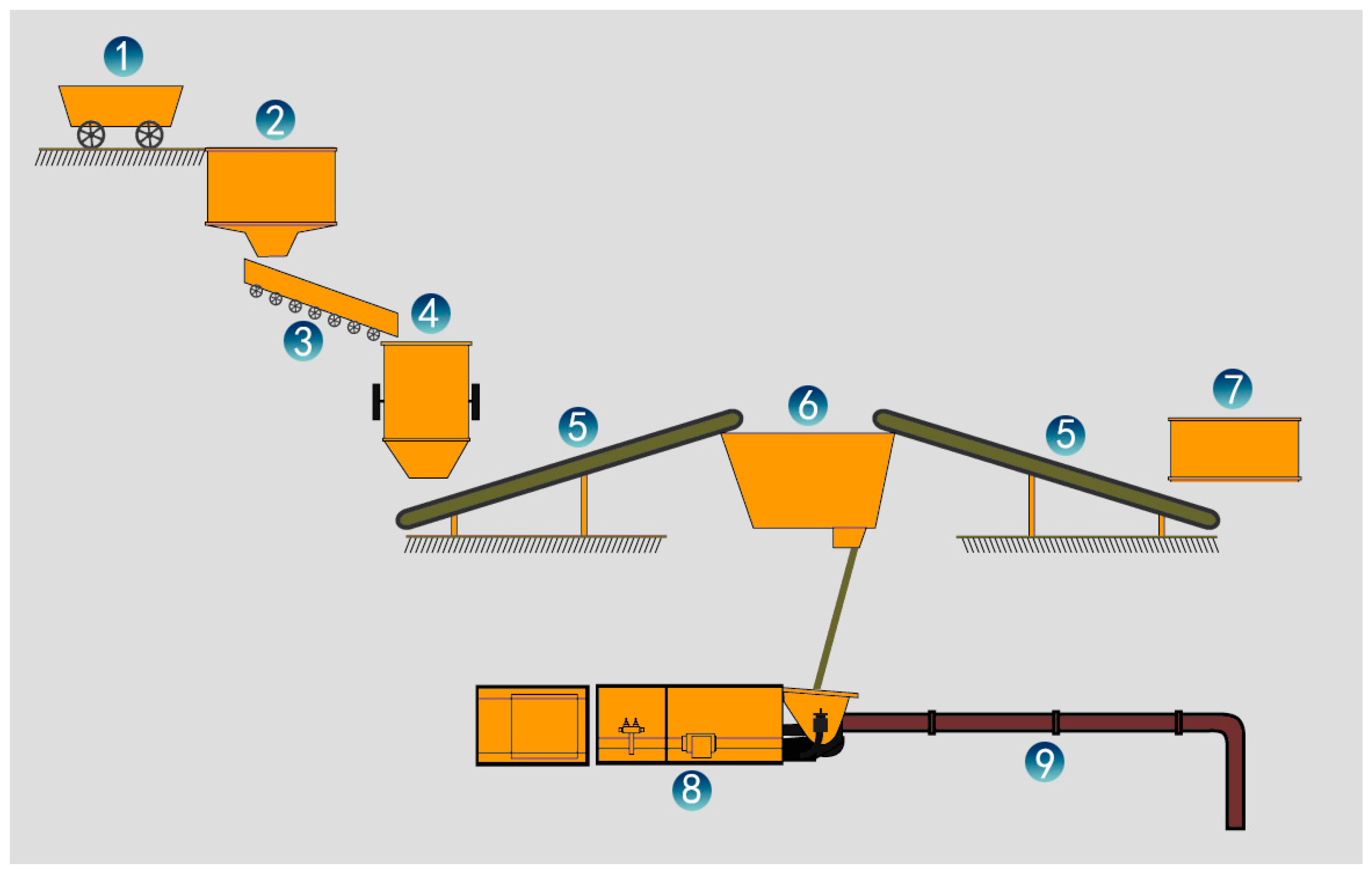
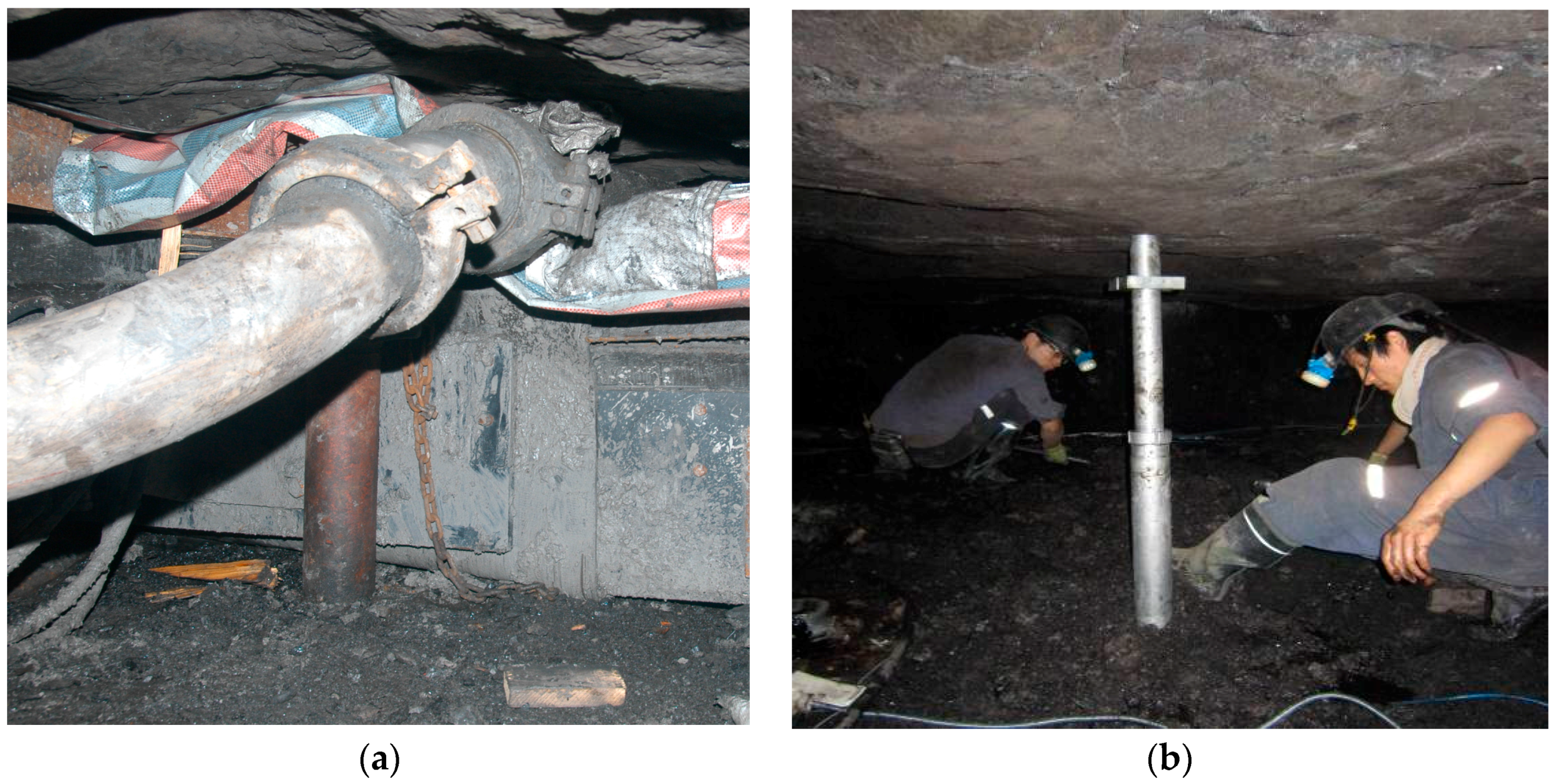
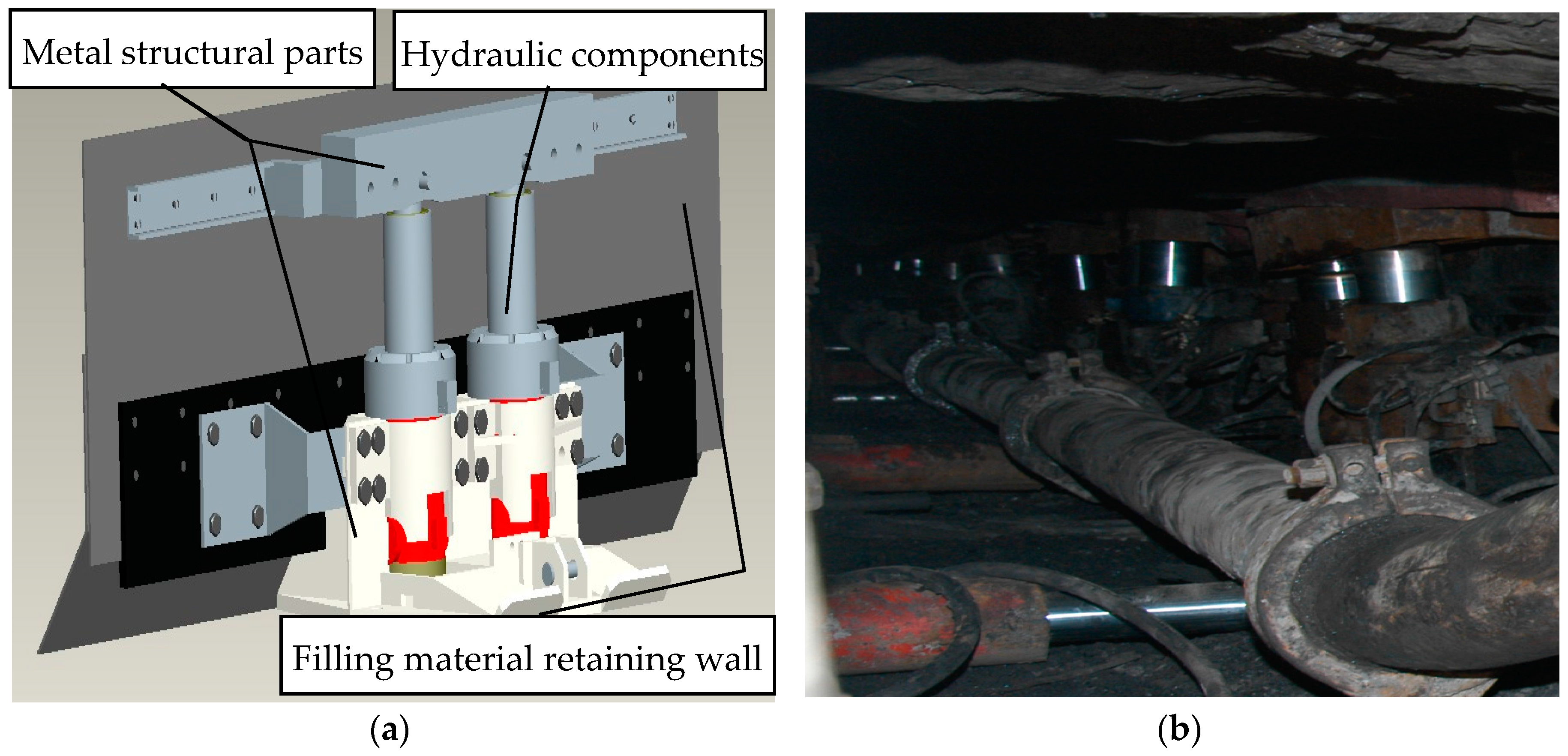
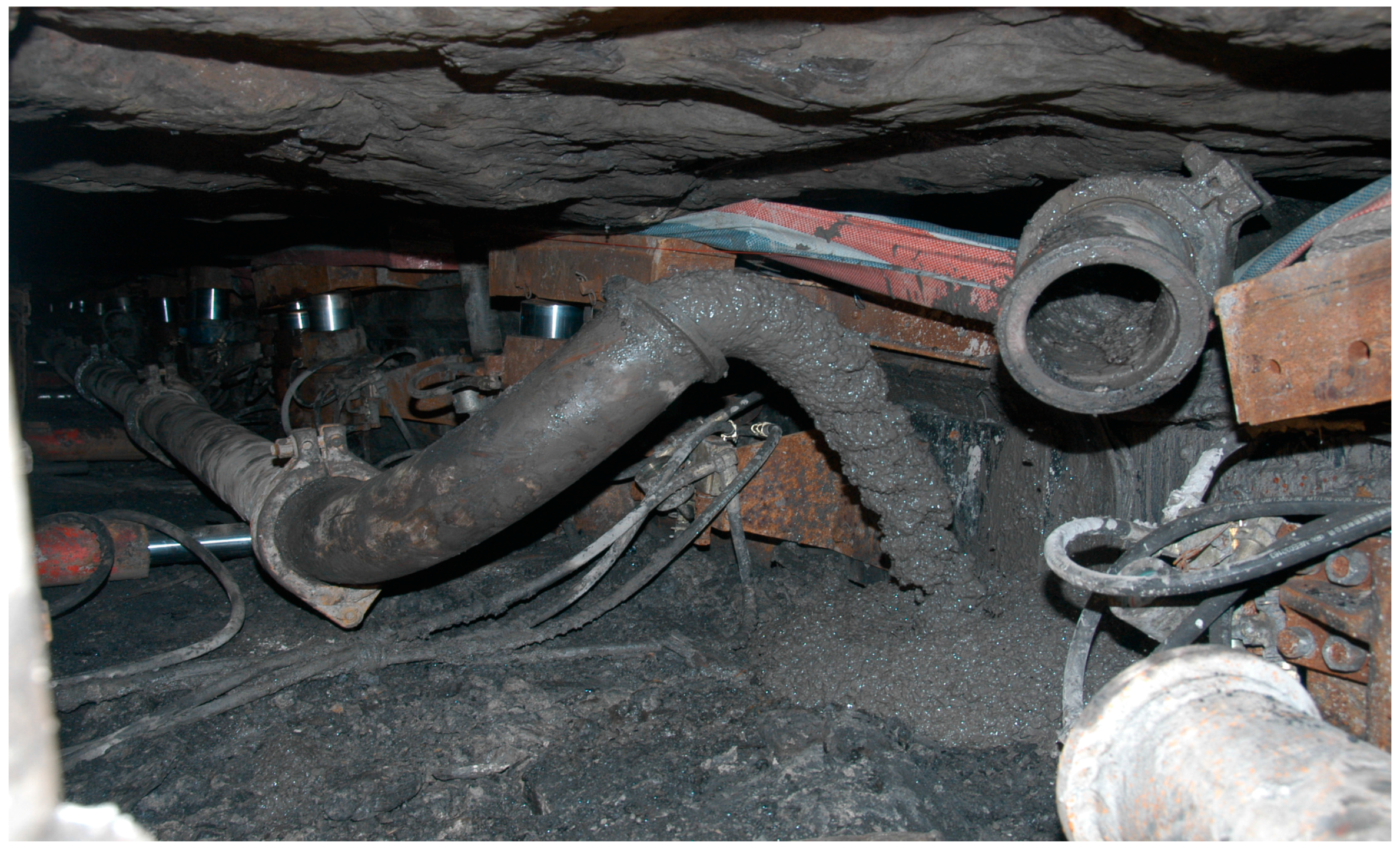

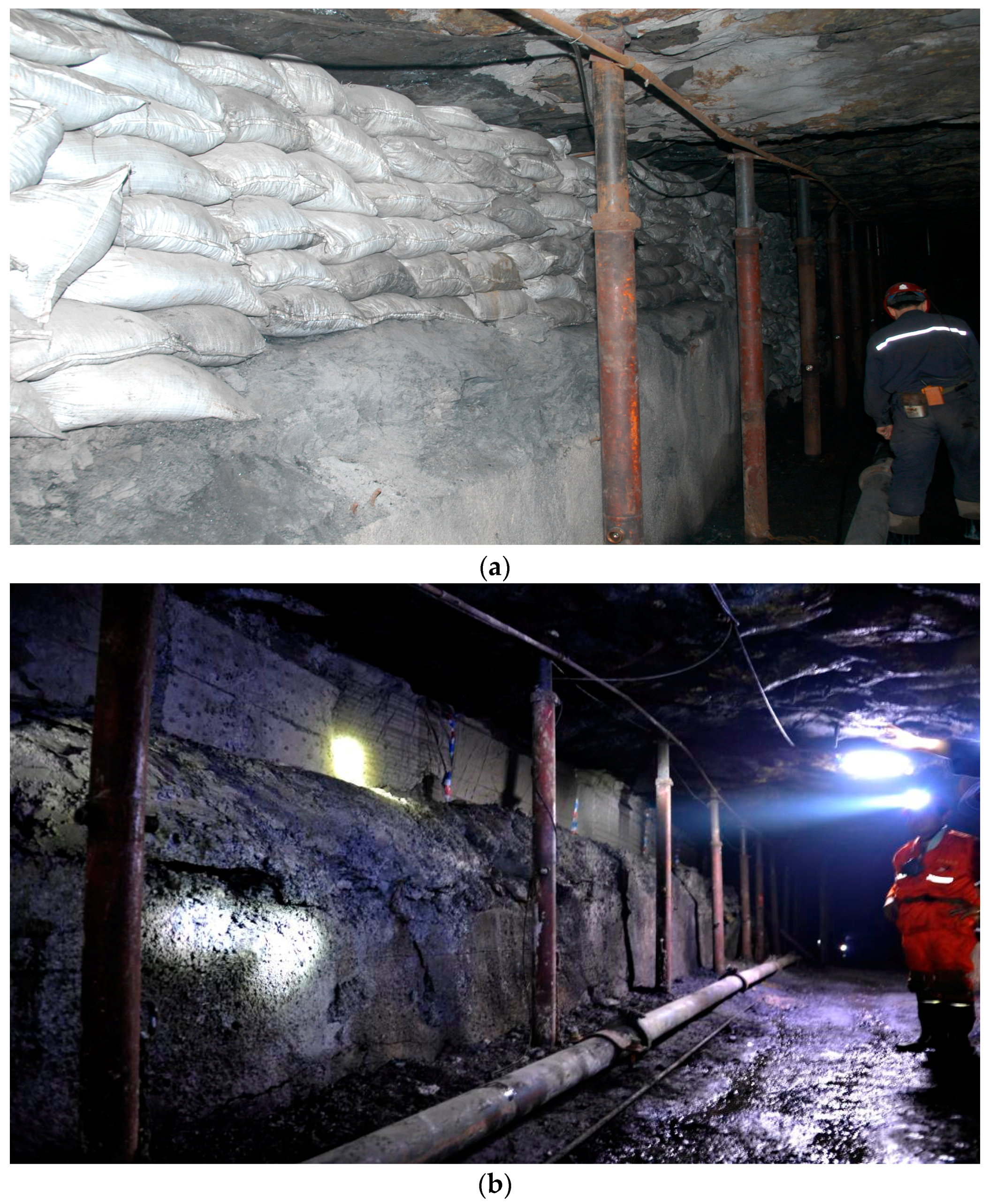
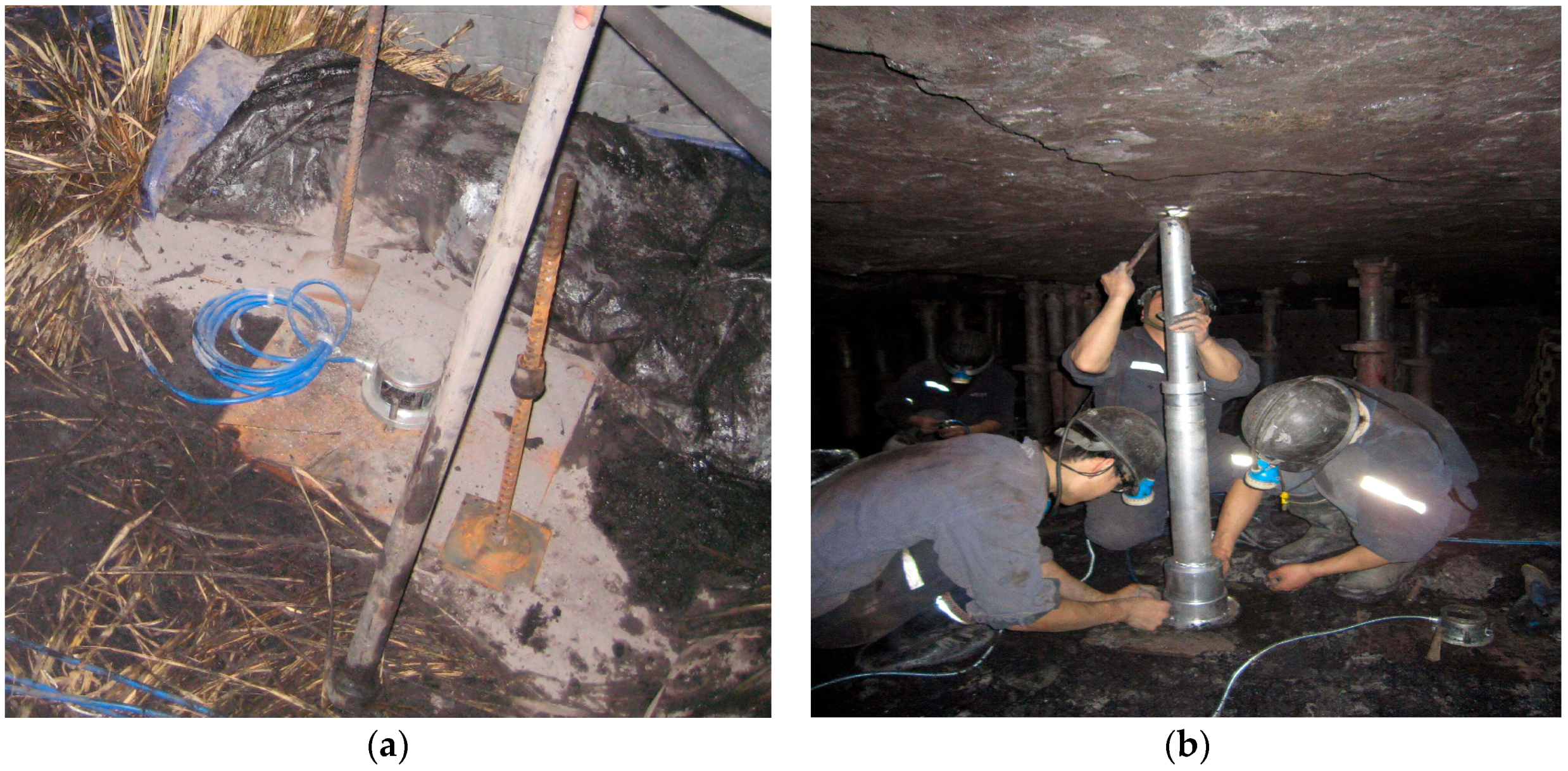
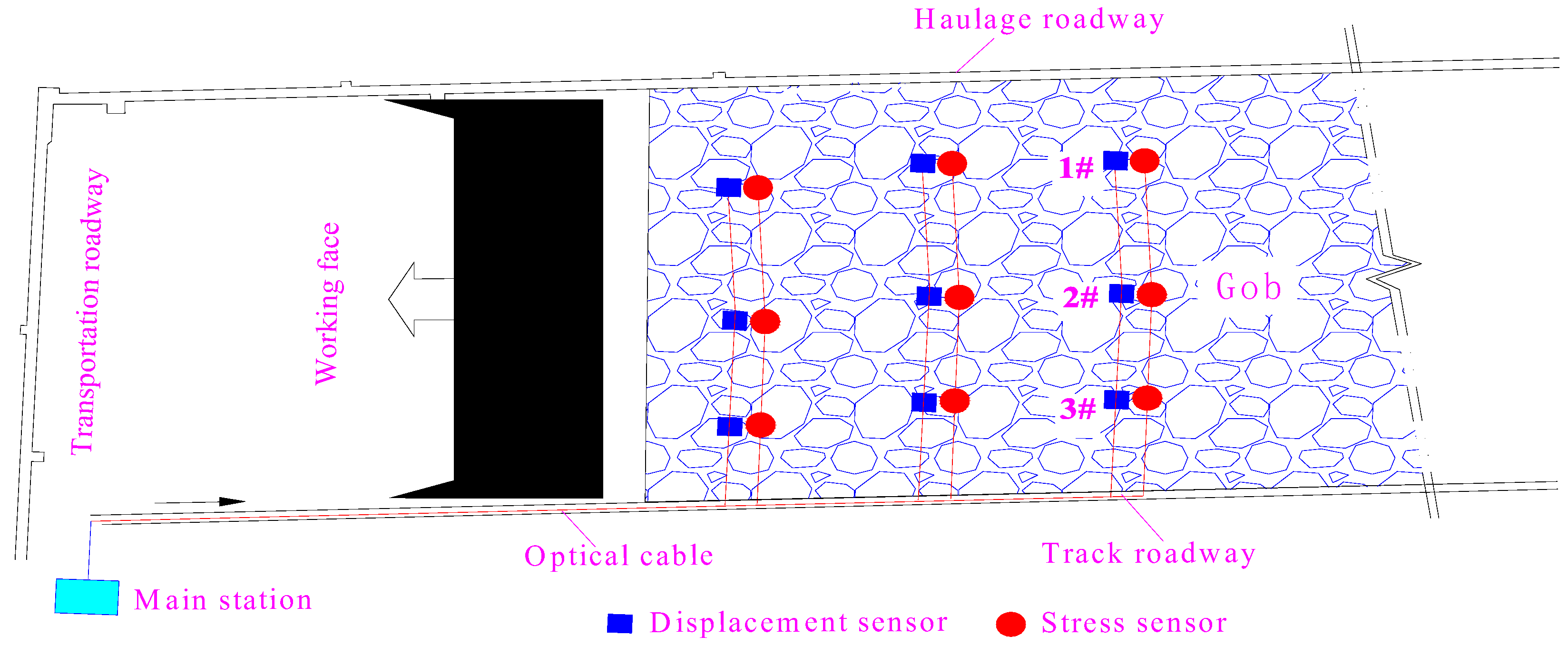
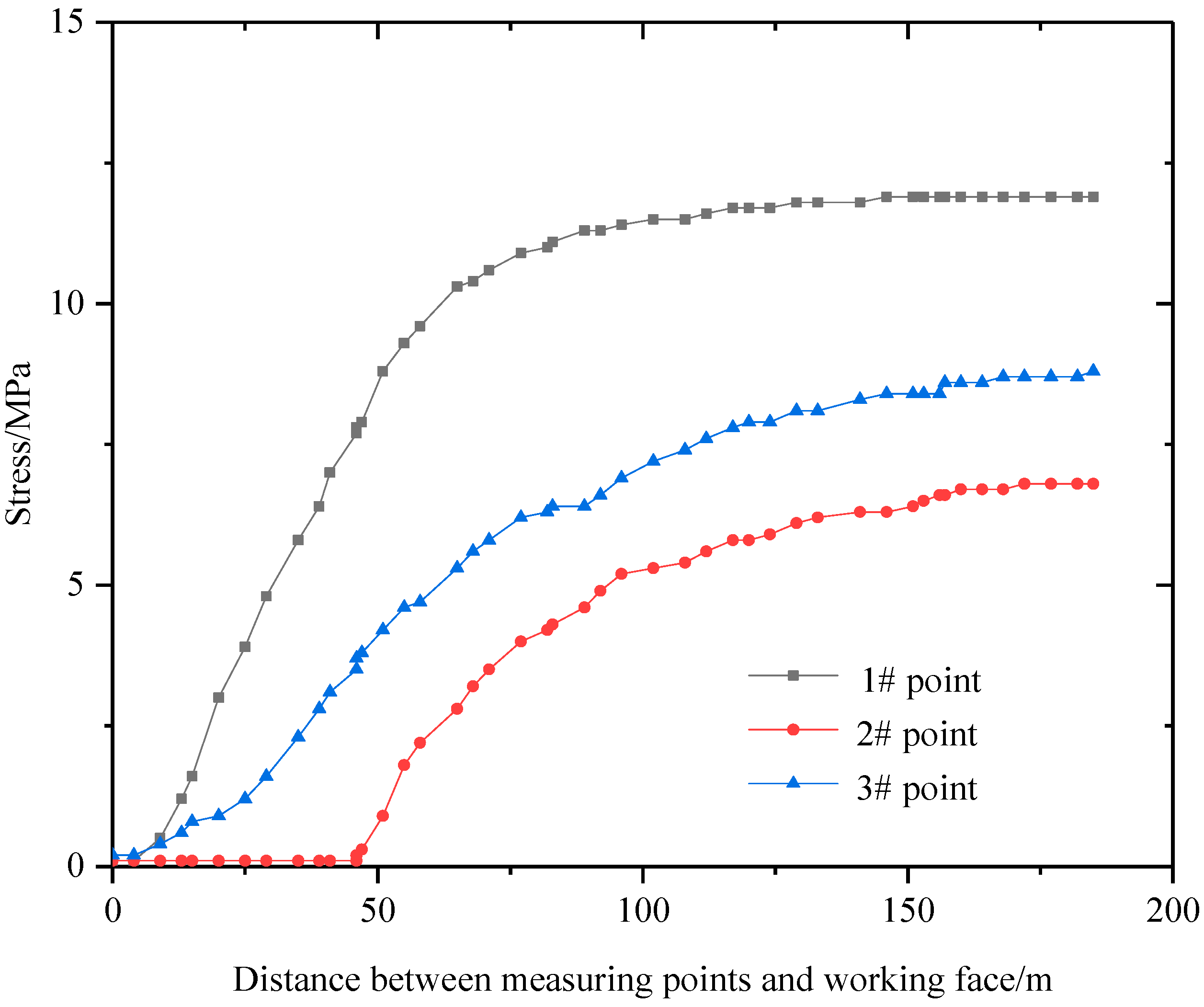

| Montmorillonite | Kaolinite | Sericite | Jarosite | Carbonaceous Shale |
|---|---|---|---|---|
| 31.5 | 11.1 | 4.6 | 13.5 | 32.4 |
| Test Item | Index Value [21] | Measured Value |
|---|---|---|
| Ignition Loss (%) | <5 | 0.95 |
| Moisture Content (%) | <1 | 0.65 |
| Sulphur Trioxide (%) | <3 | 0.81 |
| Water Demand Ratio (%) | <95 | 86 |
| Surface Area (cm2/g) | ≥6000 | 6700 |
| Material (g) | Slump (mm) | Compressive Strength (MPa) | |||||||
|---|---|---|---|---|---|---|---|---|---|
| Water | Fly Ash | Gangue | Cement | 1 d | 3 d | 7 d | 15 d | 28 d | |
| 400 | 400 | 1600 | 0 | 210 | 0.0 | 0.0 | 0.0 | 0.0 | 0.35 |
| 400 | 400 | 1600 | 20 | 220 | 0.0 | 0.1 | 1 | 1.16 | 1.45 |
| 400 | 400 | 1600 | 40 | 230 | 0.0 | 0.1 | 1 | 1.23 | 1.46 |
| 400 | 400 | 1600 | 80 | 245 | 0.0 | 0.1 | 1 | 1.24 | 1.48 |
| Equipment Name | Model | Motor Power (kW) | Rated Voltage (V) | Operational Capability |
|---|---|---|---|---|
| Crusher | PCS1000F | 110 | 660 | 80–90 t/h |
| Scraper Conveyor | SGW-40T | 40 | 660 | 200 t/h |
| Conveyer Belt | SDJ-800/75 | 75 | 660 | 300 t/h |
| Filling Pump | HBMD80F/16 | 110 | 660 | 80/40 m3/h |
| Mixer | JDY700L | 18.5 | 660 | 60 m3/h |
| Fly Ash Conveyor | QLS200 | 7.5 | 660 | 48 t/h |
© 2017 by the authors. Licensee MDPI, Basel, Switzerland. This article is an open access article distributed under the terms and conditions of the Creative Commons Attribution (CC BY) license (http://creativecommons.org/licenses/by/4.0/).
Share and Cite
Luan, H.; Jiang, Y.; Lin, H.; Wang, Y. A New Thin Seam Backfill Mining Technology and Its Application. Energies 2017, 10, 2023. https://doi.org/10.3390/en10122023
Luan H, Jiang Y, Lin H, Wang Y. A New Thin Seam Backfill Mining Technology and Its Application. Energies. 2017; 10(12):2023. https://doi.org/10.3390/en10122023
Chicago/Turabian StyleLuan, Hengjie, Yujing Jiang, Huili Lin, and Yahua Wang. 2017. "A New Thin Seam Backfill Mining Technology and Its Application" Energies 10, no. 12: 2023. https://doi.org/10.3390/en10122023






